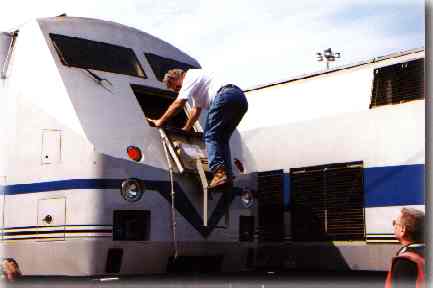Questions regarding dual mode operations of these units:
When switching from diesel/electric to electric (third rail) operation, is there a specific time the diesel engine must idle before shutdown and loading? Question asks if diesel engine is immediately shut down "hot" after operation, and how long it takes diesel engine to reach operating temperature before it will allow electrical load.
Is it possible to raise/lower third rail shoes via a trainline ciruit? Questions asks if you're operating two P32ACDM's back-to-back, can you raise/lower shoes on the trailing unit.
If operating two P32ACDM's back-to-back, can you switch both units from diesel to electric third rail operation at the same time? Question asks if you can shut down/start up the diesel engine on all units in the consist.
When operation in "push mode", cab car leading, can you control multiple units' transistion from diesel to electric third rail operation? Questions asks if two units are in the consist and both on line, can you control the transistion entirely from the cab car; raising/lowering shoes, starting/stopping of diesel engine, etc.
What is the approximate maximum train length (number of coaches) the HEP system can provide for? Question is generic in nature; I realize differences in equipment (Amtrak vs MNCR) may vary the answer.
Besides the third rail shoe hardware, are there any significant differences between Amtrak and Metro North units? Question asks can each road's units be used by the other if third rail equipment were changed/modified.
Any other "unique", or unusual, operating scenarios that are possible would be appreciated. My curiousity stems from the lack of photos I've seen of multiple P32ACDM's hauling trains; they seem to be exclusively used as single unit consists. Thank you in advance for your replies.
When switching from diesel/electric to electric (third rail) operation, is there a specific time the diesel engine must idle before shutdown and loading? Question asks if diesel engine is immediately shut down "hot" after operation, and how long it takes diesel engine to reach operating temperature before it will allow electrical load.
Is it possible to raise/lower third rail shoes via a trainline ciruit? Questions asks if you're operating two P32ACDM's back-to-back, can you raise/lower shoes on the trailing unit.
If operating two P32ACDM's back-to-back, can you switch both units from diesel to electric third rail operation at the same time? Question asks if you can shut down/start up the diesel engine on all units in the consist.
When operation in "push mode", cab car leading, can you control multiple units' transistion from diesel to electric third rail operation? Questions asks if two units are in the consist and both on line, can you control the transistion entirely from the cab car; raising/lowering shoes, starting/stopping of diesel engine, etc.
What is the approximate maximum train length (number of coaches) the HEP system can provide for? Question is generic in nature; I realize differences in equipment (Amtrak vs MNCR) may vary the answer.
Besides the third rail shoe hardware, are there any significant differences between Amtrak and Metro North units? Question asks can each road's units be used by the other if third rail equipment were changed/modified.
Any other "unique", or unusual, operating scenarios that are possible would be appreciated. My curiousity stems from the lack of photos I've seen of multiple P32ACDM's hauling trains; they seem to be exclusively used as single unit consists. Thank you in advance for your replies.

